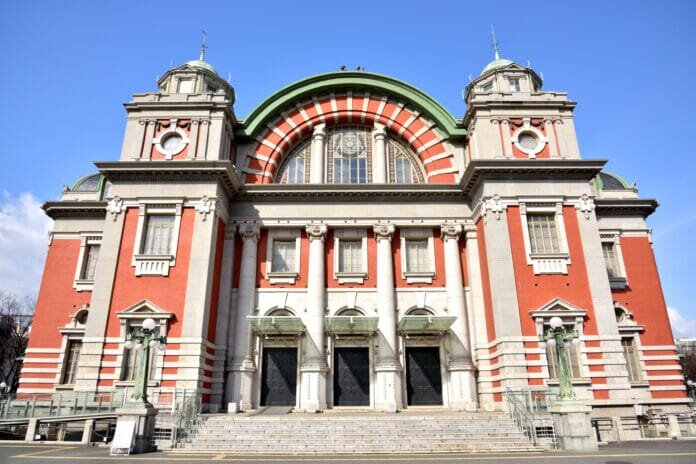
The Osaka area has been settled since early Japanese history, becoming the site of port towns and a key location for trade while the nation was still in its infancy. Now, it is one of Japan’s largest and most densely populated urban areas, and is often contrasted with Tokyo, the capital city. This essay will look at Osaka’s political history to see the changes that occurred in the area between the early days and modern times. The first point will be to explore the history of Naniwa, a port settlement that existed in what is now central Osaka City, and which was itself a capital of Japan used by early emperors. Next, we will see how the area was affected during the tempestuous mediaeval era, and how cities like Osaka and Sakai came out of that tumult and grew during the Edo Period, before going on to the practical changes that occurred during modern Japan and some major events and names coming out of Osaka in the 20th century. Finally, the focus will shift to today, where stories about Osaka’s politics are dominated by the rise of former mayor Hashimoto Toru and his political party, Ishin no Kai, and go into some detail about their plans for reform in Osaka, as well as some other recent developments in local politics. Political history of Osaka
Table of Contents
The Rise and Fall of Naniwa
Though the name Osaka did not come into widespread use until around the 16th century CE, the area was settled for many centuries before this time, including under the early name Naniwa.[1] The port town of Naniwa-zu was well-positioned for trade and diplomacy, situated on a peninsula between the Seto Inland Sea to the west, and Kawachi Lake to the east, where the major Yodo and Yamato rivers met the sea. The geography of the region then differed significantly from the modern city, not least with the very existence of Kawachi Lake, which in the intervening years has been filled in and is now the site of much of eastern Osaka Prefecture.[2] Early records on the political significance of Naniwa-zu are of limited reliability, as they appear in official documents such as the 8th-century Nihon shoki, which brought together myth and history to provide a narrative legitimising early imperial rule.[3] According to the Nihon shoki, the semi-legendary Emperor Nintoku, traditionally said to have ruled in the 4th century, ordered a major early public engineering project in the form of the excavation of Naniwa-no-horie, a canal connecting Kawachi Lake with the sea.[4] This may be when the port town was first established. Moreover, Naniwa is claimed to have been where Nintoku established his capital, indicating that it was not only a valuable site for international relations but also the developing nation’s political centre.[5] Another connection between Nintoku and the area can be seen in the Daisenryo Kofun, an enormous keyhole-shaped mound said to be Nintoku’s burial site. This kofun is part of the Mozu-Furuichi group in modern-day Sakai City, which was inscribed in 2019 as a UNESCO World Heritage Site.[6] While the historicity of Emperor Nintoku’s reign and its details are questionable at best, the strength of the purported association with Nintoku suggests that Naniwa was a place of great political importance at this time.
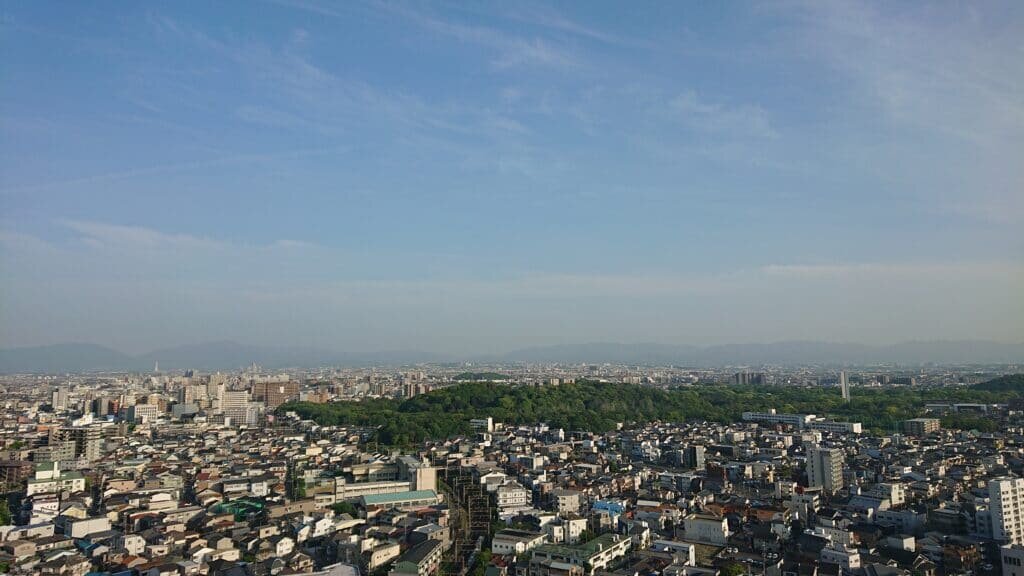
Regardless of whether or not the stories of Emperor Nintoku are accurate, Naniwa was certainly home to a major port town, and in the 7th century, it verifiably became the seat of imperial power. Naniwa was the capital city of Emperor Kotoku, under whose rule the Taika Reforms of 645 were carried out, changing various aspects of government to more closely match Chinese customs. In addition to new systems of ranking and taxation, the relocation of the imperial residence to Naniwa from Asuka – in modern-day Nara Prefecture – was a part of these reforms.[7] The palace at Naniwa continued to be the seat of power until Kotoku’s death in 654, but after this the capital returned to Asuka, the base of Kotoku’s nephew and crown prince Naka no Oe. Naka no Oe is generally regarded as having pulled the strings during Kotoku’s reign, orchestrating Kotoku’s accession and perhaps even being the brains behind the Taika Reforms; he would later take the throne himself, as Emperor Tenji. However, recently it has been argued that while Naka no Oe was certainly a powerful figure for many years, his great reputation is at least in part due to the fact that the narrative of the Nihon shoki focuses on supporting him and his descendants, resulting in the role of Kotoku – and Naniwa – being diminished in official records. On the contrary, some evidence suggests that the capital at Naniwa was more important than documents like the Nihon shoki imply. For example, Naniwa-zu is mentioned in a short poem in the preface to the 10th-century poetry compilation Kokin Wakashu.[8] Known as the “Naniwa-zu poem”, it was apparently used often as a practice piece in the study of calligraphy, and was later regarded as a widely known poem. In the poem, blooming flowers are described; since this is not an image likely to be associated with the marshy area of Naniwa, scholars have suggested that it is a metaphorical idea reflecting a glorious renewal upon the establishment of the new capital. Besides calligraphy practice, archaeological findings show that the poem was also inscribed on objects unlikely to be read, suggesting a ritualistic purpose perhaps intended to honour Emperor Kotoku and his palace. Indeed, the palace itself appears to have been grand. Evidence of the palace remains were scarce for many years, but beginning in the 1950s, excavations have been carried out, discovering more details about the palace little by little.[9] These findings uncovered evidence that the palace was likely far larger than had previously been believed, and that it featured unusual and innovative structures including techniques brought from mainland Asia. Altogether, the archaeological evidence creates a different image of Naniwa from that depicted in the Nihon shoki, suggesting that its time as Japan’s capital was far more than a mere historical footnote.
After the end of Emperor Kotoku’s reign, the capital moved but the palace compound continued to be used. Naka no Oe, at this time supporting the second reign of his mother, the Empress Saimei, used Naniwa as a base during a naval campaign providing aid to the Korean kingdom of Paekche. When Naka no Oe later became emperor himself, he moved the capital further away, this time to Otsu in today’s Shiga Prefecture. However, Naniwa’s political importance continued in the years that followed, with the Emperor Tenmu declaring soon afterwards that he preferred to follow the Chinese practice of dual capitals, and desired to have one in Asuka and one in Naniwa.[10] It is unclear if these plans ever came to fruition, however, and the palace at Naniwa was apparently destroyed in a fire in the year 686. During the 8th century, Emperor Shomu ordered the rebuilding of Naniwa palace, on the basis of its prior use by Kotoku and Tenmu. The new palace was even made the official capital once again for a short time, but Shomu soon returned to Heijo-kyo in modern Nara Prefecture. Remains of both the original palace and Shomu’s reconstruction have been found since the 1950s. Throughout the 8th century, the palace at Naniwa continued to be used for official purposes, and the town remained a centre for trade, taxation and diplomacy.
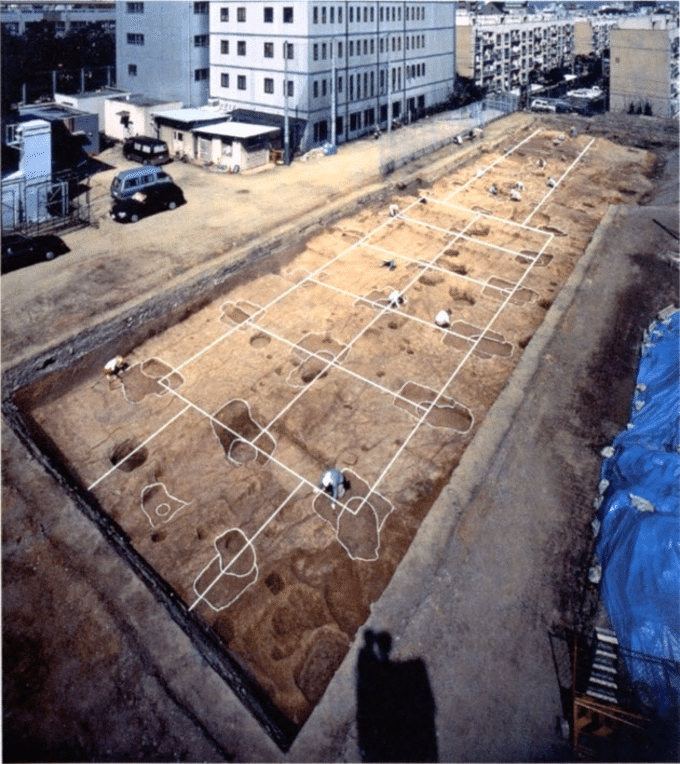
Source: Nikkei
Though Naniwa was a crucial political centre from at least Emperor Kotoku’s time, if not earlier, until the late 8th century, this did not last. In 793, Emperor Kanmu moved the seat of power from Heijo-kyo to the new capital of Nagaoka-kyo, in what is now Kyoto Prefecture. As part of the construction of Nagaoka-kyo, he had the palace in Naniwa torn down; later projects created canals allowing boats to bypass Naniwa entirely, thus further diminishing its significance. It is likely that this was due to the fact that Kanmu was of a different branch of the imperial line from Tenmu and therefore wanted to signify a clear break from sites associated with Tenmu’s branch. The capital soon moved again, to Heian-kyo, which is now Kyoto – this remained Japan’s capital city almost continuously until the 19th century. While Heian-kyo flourished as a political and cultural centre, representing what is seen as the height of Japan’s classical era between the late 8th and late 12th centuries, Naniwa and much of the area comprising modern-day Osaka faded into obscurity.
Settsu, Kawachi and Izumi Provinces in Mediaeval Times
In Emperor Nintoku’s time, political authority had yet to be fully consolidated and the nation’s administrative structure was fairly loose. Kotoku’s Taika Reforms, however, laid the groundwork for a new system called ritsuryo, which imitated the legal and bureaucratic systems of China.[11] Among the new developments introduced under the ritsuryo system was the establishment of provinces as official administrative divisions. After some adjustments in the early years, there were over sixty provinces of Japan, grouped into a number of geographic regions. By the time the ritsuryo system was firmly established, Naniwa’s glory years were already over, and so we lose the location as a focal point from here onwards; however, we can still examine the history of the Osaka area during this time by looking at the provinces corresponding to modern Osaka Prefecture. The largest of these was Settsu Province, which comprised the area of today’s Osaka City – going as far south as the area around Sumiyoshi Grand Shrine – and Kobe City, as well as the area in between, and other land now part of northern Osaka Prefecture and eastern Hyogo Prefecture.[12] Kawachi Province consisted of much of modern-day eastern Osaka Prefecture, where cities including Higashiosaka, Yao and Kawachinagano can now be found, but which was originally home to Kawachi Lake, the body of water to the east of Naniwa which was gradually turned into liveable land over time.[13] Finally, Izumi Province was in what is now the southern part of Osaka Prefecture.[14] Today’s Sakai City can be found in approximately the area where the three provinces met; the name Sakai, which first appeared in the 11th century CE, is believed to be based on its location, originally meaning “border”.[15] The provinces of Settsu, Kawachi and Izumi were all in Kinai, the “capital region” which also included the provinces of Yamashiro and Yamato, home to Kyoto and Nara respectively. Being close to the long-term capital of Kyoto, the three provinces were associated with several major political figures and events during the centuries following the end of the Heian Period.
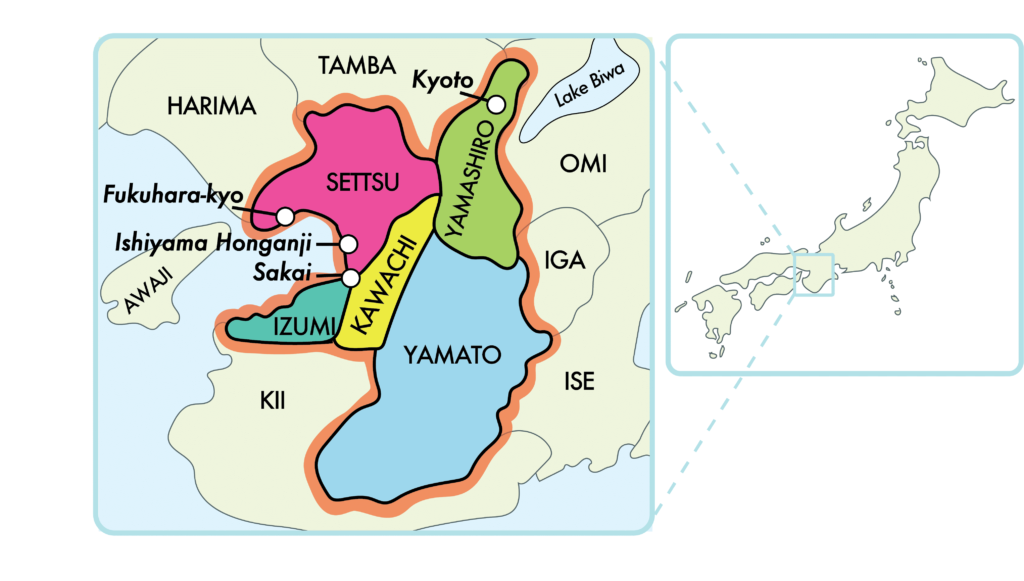
Firstly, the region played a role in the events that brought the Heian Period to a close. During the Heian Period, when imperial authority was strong and Japan was generally at peace, the royal family grew and individuals were removed from the dynastic lineage, being given honorary family names instead.[16] This produced two powerful clans: Minamoto (or Genji) and Taira (or Heike). The two clans became fierce rivals, vying for political power alongside the emperor, with violence breaking out multiple times during the 12th century. The repeated success of Taira no Kiyomori, head of the Taira clan, in putting down Minamoto-led unrest led to increasing strength at court for the Taira clan, but this in turn put a target on their heads. Kiyomori devised a plan to move the capital from Heian-kyo to the new site of Fukuhara-kyo in Settsu Province, now part of Kobe City.[17] Kiyomori also arranged for his grandson to take the throne as Emperor Antoku despite being only two years old, and although the child emperor did visit Fukuhara-kyo, the project ultimately failed, instead contributing to the beginning of a full civil war between the Taira and Minamoto clans, known as the Genpei War. Before and during the war, many of the leading figures on the Minamoto side belonged to the Kawachi-Genji branch, which was traditionally based in Kawachi Province.[18] Locations within the area became sites of various battles and other events, including the famous Battle of Ichinotani, which took place near present-day Kobe and saw a decisive victory for the Minamoto clan, paving the way for their ultimate triumph soon afterwards.[19] This is one of the many battles depicted in The Tale of the Heike (Heike Monogatari), a classic work of Japanese literature that chronicles the events of the Genpei War. Following the war, Minamoto no Yoritomo, who had become the head of the Minamoto clan, installed himself as Japan’s first shogun, thus beginning a long era of military rule.[20]
Under the rule of Yoritomo and his successors, the emperor in Kyoto was nominally still the head of the Japanese state, but practically the shogun held political authority.[21] A system was established whereby the shogun posted regional governors as replacements for a previous imperial post, allowing the military government based in Kamakura to exercise control over the entire country.[22] This kind of feudal system persisted for the next several hundred years, though power changed hands at many points during that time, such as when Ashikaga Takauji brought the existing military government to an end in the early 14th century.[23] Initially sent to Kyoto by the Kamakura government to deal with the emperor’s insubordination, Takauji, whose family claimed descent from the same branch of the Minamoto clan as Yoritomo before them, likely resented the fact that during that period, a great deal of power was held by the Hojo clan, themselves descendants of the Taira clan. He soon betrayed the shogun and supported a restoration of the imperial government, but after only a few years, he emerged at the top of yet another power struggle and was bestowed the title of shogun himself. Under the Ashikaga family, regional governors became increasingly wealthy, turning from government officials into feudal lords. This allowed some families to gain great power, such as the Hosokawa clan, who were also descended from the Kawachi-Genji line of Minamoto, and who ruled over Settsu and Izumi among other provinces.[24] When the Ashikaga family grew weak and there was once again a struggle over which clan would hold the reins, a succession dispute led to the Onin War, another civil war in which the Hosokawa clan fought the Yamana clan.[25] The outcome of the Onin War was that the Hosokawa clan, who already controlled the Kinai provinces and several others, wielded true political power while the shogun was a mere puppet. This situation then led to the Sengoku (or “warring states”) Period.
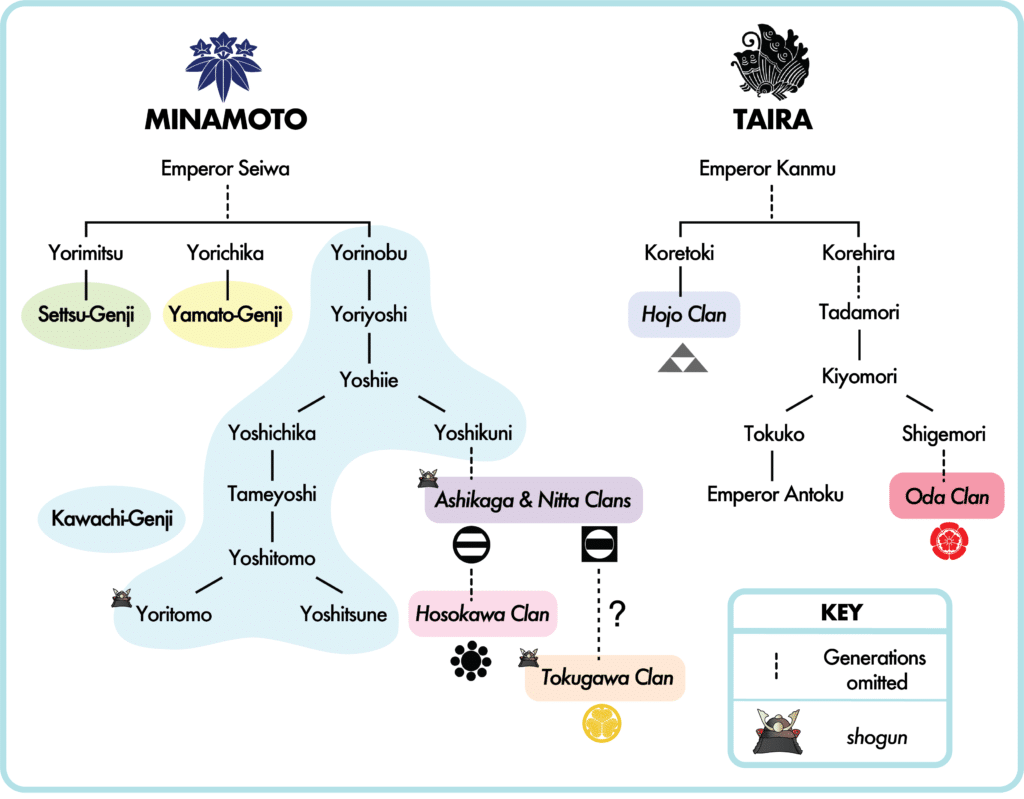
In the Sengoku Period, no central authority held control over Japan, with governors being usurped and replaced by local warlords.[26] For example, the Hosokawa clan, who had dominated the Kinai region and the military government, were superseded by the Miyoshi clan, their former retainers.[27] The Miyoshi clan were therefore the main force in Settsu, Kawachi and Izumi during the early Sengoku Period. However, this was a deeply unstable time, and even within provinces there were areas under the control of other lords, as can be seen in the sheer numbers of castles that were built around the country as strongholds for local clans. An interesting case of this kind of decentralised power is Sakai. As mentioned above, Sakai straddled the boundary between Settsu, Kawachi and Izumi, and during the Sengoku Period, it operated as a “free city”, governed by a council of merchants rather than by a samurai clan.[28] As a commercial city, Sakai was patronised by some of the most ambitious warlords of the day, who obtained arms and money there.[29] In spite of Japan’s political instability – or perhaps because of it – Sakai developed during this time from a fishing village into a major centre for domestic and international trade.
Meanwhile, a little further north in Settsu Province, the city of Osaka was taking shape. This began when a militant Buddhist sect was forced to relocate to Settsu after their previous stronghold in Yamashina, near Kyoto, was destroyed.[30] On the former Naniwa palace site they built Ishiyama Honganji, a temple from which they opposed the military might of Oda Nobunaga, a warlord known for military skill and mercilessness, who finished off the Ashikaga shogun line and sought to bring all of Japan under his control. A town called Osaka quickly developed around Ishiyama Honganji, and when Nobunaga’s armies neared, the Miyoshi feudal lords and the Honganji forces worked to protect Osaka from invasion.[31] Nobunaga, headquartered in Sakai, led a protracted siege, and eventually Ishiyama Honganji fell to the attacking forces. However, Nobunaga’s rule over the area was short-lived, as he was soon killed, leaving his follower Toyotomi Hideyoshi to take his place.[32] Hideyoshi’s reputation was for a more diplomatic approach than his old master, but he still continued to pursue Nobunaga’s goal of unifying Japan, and beginning in 1583, he had Osaka Castle built where Ishiyama Honganji had previously stood.[33] The castle remained his stronghold while he established control over the more distant provinces of Japan, and after his death it was used as a base by his son. Soon, however, a power struggle erupted among the supporters named by Hideyoshi to act as regents for his young son, leading to further warfare, in which the third great figure in Japan’s reunification, Tokugawa Ieyasu, fought against the Toyotomi family.[34] In the Osaka Campaign, Tokugawa laid siege to the castle, with his victory representing the end of the last remaining opposition to his own national unification project. Tokugawa became the new shogun, ending the Sengoku Period and beginning the Edo Period, an era of peace lasting over two centuries.
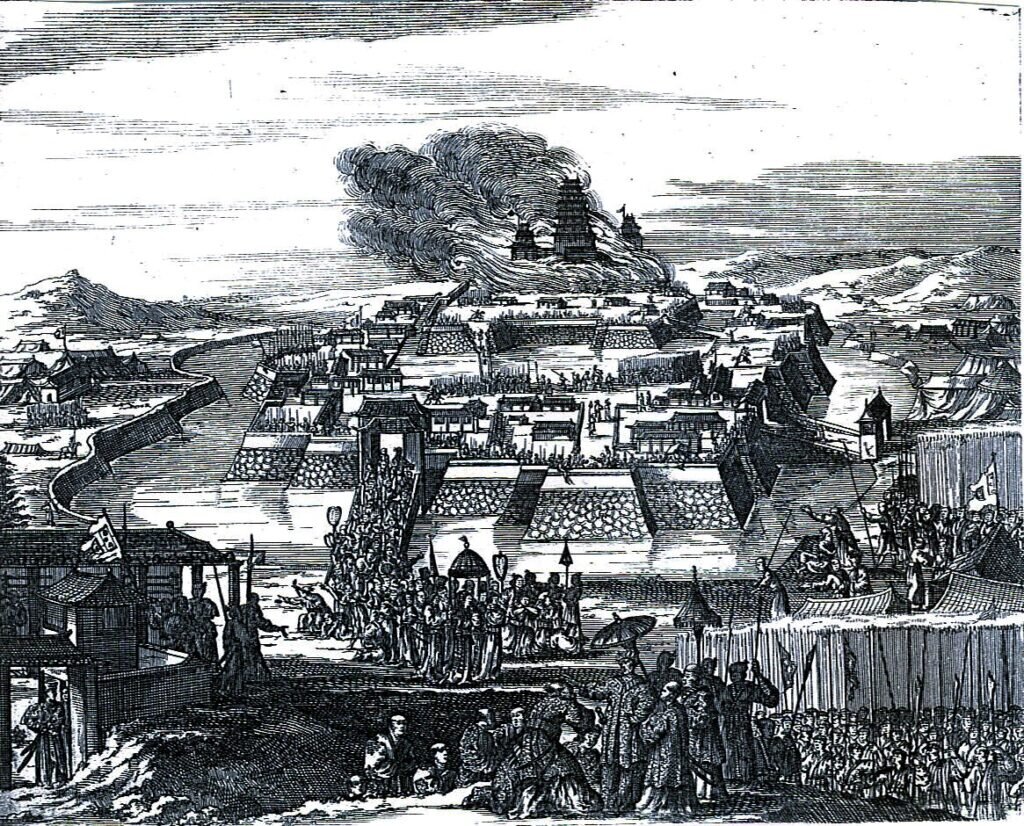
Source: Wikipedia
During mediaeval times, the situation in the Osaka area was very much the same as what was going on all over the country. Military leaders came and went, centralised government gradually dwindled, and civil war was never far away. The provinces of Settsu, Kawachi and Izumi, which consisted of roughly the area where Osaka Prefecture is today, provided the location for many major battles in struggles between different samurai clans, and the proximity to Kyoto meant that the three provinces were often under the control of the most powerful families in Japan. Furthermore, as the national political situation fell apart entirely and entered the Sengoku Period, cities like Sakai and Osaka soon grew and became key strategic locations. Toyotomi Hideyoshi founded Osaka Castle and oversaw major social and political upheaval: his tax reforms and rigid new class system laid the groundwork for structures that persisted throughout the Edo Period.[35] For these reasons, while it is true that the previous importance of Naniwa disappeared during the Heian Period, leaving the area on the periphery of political power for centuries, the circumstances of the mediaeval era also led directly to the development of Osaka and, in the Sengoku Period, positioned it once more at the centre of political change in Japan.
Edo Period Politics in Osaka
In the Edo Period, political authority was held by the samurai, or military class. However, though they were nominally warriors, the peace established at the end of the Sengoku Period meant that in general, their military skills were not put to use, and they were more likely to perform bureaucratic functions instead.[36] According to the four-tiered caste system implemented by Toyotomi Hideyoshi and maintained – to varying degrees – by Tokugawa Ieyasu and his descendants, the samurai were followed in the social order by farmers and peasants, then artisans, and then merchants. In addition, the emperor and clergy were separate from the four classes, as were outcaste groups called eta and hinin, who worked in taboo professions. The Edo Period is also when the sakoku policy was implemented, severely restricting trade and diplomacy with the world outside of Japan.[37] The class system and foreign policy served as a backdrop during the Edo Period, and their later unravelling ultimately spelt the end of this time in Japanese history and led to the modern era. The aim of this section is to consider Osaka’s place during this time, how it was run and important events that occurred.
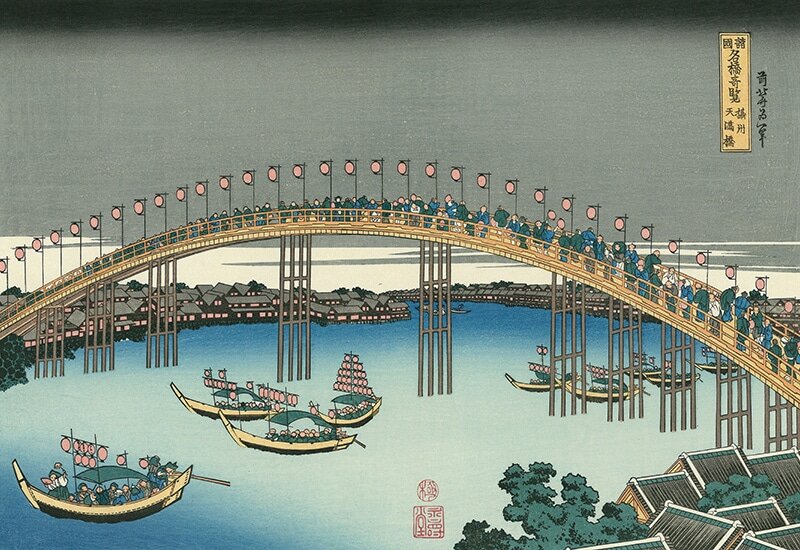
Source: Adachi Hanga
In terms of location, while it is useful to look at the provinces of Settsu, Kawachi and Izumi in mediaeval Japan, during the Edo Period the province was no longer a particularly relevant administrative division. Provinces continued to exist, but a more important category was the feudal domain, or han. These developed from local lords’ private lands, but under Hideyoshi, they were utilised as a means of keeping these lords loyal to the central military government.[38] He ordered major land surveys which determined the value of land in terms of the output of rice or equivalent production, then worked out ownership and the amount of tax that should be levied. Especially after Tokugawa became shogun of the united Japan, this centralised order for taxation enabled greater political control and maintained a hierarchy with the shogun as the undisputed leader. Specific means by which local lords were kept under control included the sankin kotai system, under which lords were expected to spend one year in their domain, then one year in Edo – today’s Tokyo – where the military government was based, then returning to their domain, and so on, continually moving back and forth.[39] Other than requiring lords to act as vassals to the shogun, the central government also exercised direct control over a great deal of land including some of the country’s major cities, including Kyoto and Osaka.[40] The government’s main representative in Osaka was the castellan, usually a high-ranking member of the Tokugawa clan, whose jurisdiction was the newly rebuilt castle and the surrounding town.[41] The Osaka castellan was an important position, and many of those appointed to the role later went on to become Elders – members of the military government’s highest decision-making body. In addition to the castellan, city magistrates were sent from Edo to oversee administrative and judicial affairs in Osaka; they also came to have authority over governance of the entirety of the provinces of Settsu and Kawachi, and later Izumi, Harima (part of today’s Hyogo Prefecture) and beyond.[42]
Though official positions such as castellan and city magistrate were of course important, they do not tell the whole story about Osaka. While Edo was the city of government, and therefore dominated by people of the warrior class, Osaka’s population consisted largely of the urban classes, particularly merchants, with only low numbers of samurai.[43] Meanwhile, although the Edo Period government had political power over all domains and demanded obedience from lords, the economic system was decentralised, meaning that the practical realities of taxation and governance could vary. In Osaka’s case, taxation, commercial regulation and record-keeping were largely implemented by the civilian population, contributing to the growing influence of the merchant class in the city. The homes of Osaka’s townspeople were organised into three districts: Kita, Minami and Tenma. These were further divided into hundreds of self-governing neighbourhoods, which served as a basic low-level administrative unit.[44] Each neighbourhood had a local administrator, often selected through a process where district chiefs chose from candidates nominated by neighbourhood landowners. Landowners were also expected to perform various duties as part of their obligation to take collective responsibility for the neighbourhood’s administration. As these duties increased, people were employed to take on roles such as guards and watchmen, including from outcaste groups who otherwise lived in designated villages. This self-governing structure meant that locals were generally left to their own devices with regard to organisation, while samurai officials took a hands-free approach provided everything ran smoothly.
For many merchants in Osaka, everything certainly did run smoothly for much of the Edo Period. Osaka became a wealthy city with the country’s most important rice market and monopolies over several industries. Merchants in Osaka became extremely influential and came to take pride in being “merchants of the nation” providing goods all over the country.[45] Over time, the increasing lack of duties for samurai led to extravagance, and due to financial problems, they ended up in debt to moneylenders of the merchant class. Soon, a combination of financial disorganisation by the ruling class, profiteering by now powerful merchants, and periods of famine led to increasing unrest in the early 19th century. In the 1830s, this came to a head, with riots led by peasants, who suffered the most from famines, breaking out nationwide.[46] In Osaka, a policeman from a samurai background by the name of Oshio Heihachiro witnessed widespread corruption and became known for his contrasting integrity. After retiring from the police, he was inspired by Confucian philosophy and urged the authorities to take action to help impoverished farmers, but after being refused, he led peasants in a famous revolt in 1837. The revolt was swiftly put down and Oshio perished, but although the riot itself ended in failure, it encouraged similar action around the country, signalling the beginning of the end of the Edo Period.
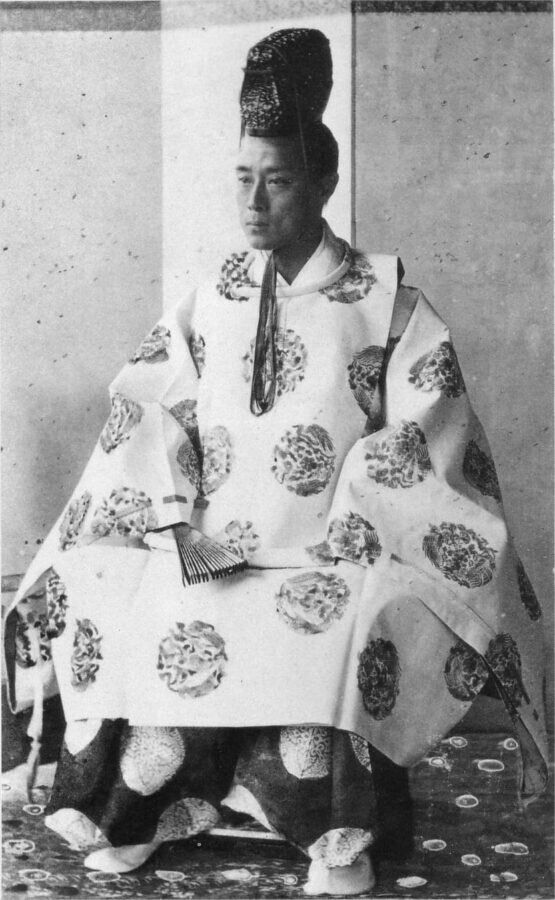
Source: Wikipedia https://commons.wikimedia.org/wiki/File:1867_Osaka_Yoshinobu_Tokugawa.jpg
Roughly the last two decades of the Edo Period are known as the Bakumatsu era. This time is known for a great deal of political turmoil as various factions competed for supremacy, while Western powers arrived on the scene to restart foreign trade, diplomacy and settlement.[47] Renewed international trade and the taxation that came with it quickly exacerbated existing economic problems, and groups soon emerged within Japan directly opposing the shogun and favouring a return to imperial rule. Osaka Castle was used as a base by the last two shogun in their efforts to suppress rebels, who were often from domains in Kyushu but staged many attacks in Kyoto.[48] As well as being a strategic location for dealing with violence in Kyoto and in the southern parts of the country, Osaka was also used for conducting diplomacy. Tokugawa Yoshinobu, the final shogun, hosted several ambassadors from Western countries at Osaka Castle, but although these meetings were reportedly rather successful, there was ultimately no way of stopping the inevitable move against the military government.[49] War broke out in early 1868, after the shogun first resigned, then attempted to defeat the pro-imperial rebels after all, sending troops from Osaka to Fushimi, south of Kyoto.[50] However, his army was underprepared to handle the rebel forces who were more experienced and better equipped with various French and American weaponry.[51] The battle resulted in humiliation for the shogun, who then slipped away from Osaka, where the new government began implementing modern policies and encouraging foreign powers to recognise the legitimacy of the new regime. Although the war continued thereafter, pushing forces loyal to the old system further north through Japan, the political power of the shogun was no more as soon as he abandoned Osaka. Therefore, although the military government was situated in Edo for over two hundred years, it came to an end in Osaka, just as remaining opposition to the Tokugawa forces had been finally defeated there in the Sengoku Period.
Osaka Politics in the Modern Era
The end of the Edo Period was followed by a time of rapid modernisation. Many of Japan’s new leaders came from the same coalition that had fought against the shogun and restored the emperor’s authority.[52] The early years after the Meiji Restoration were not straightforward, as the inexperienced new leaders struggled to deal with pressures from both inside and outside of Japan, generally taking a pragmatic approach in dealing with varied issues such as economic instability, rebellions and the renegotiation of international treaties. In the 1880s, the push for a constitutional system gained traction, leading to the publication of a constitution by the end of the decade. This was followed by Japan’s first national election in 1890, in which suffrage was granted to an extremely limited section of the populace, consisting of male citizens over the age of 25 who had paid a sufficient amount in taxes.[53] In the remainder of the 19th century and especially in the 20th century, Japan continued to develop as a “modern” nation, improving the country’s infrastructure and military, and soon competing with Western powers in imperialist ambitions. Eventually this led to Japan invading neighbouring countries and entering the Second World War as aggressors; after their defeat, democracy was promoted once more. This section will focus on Osaka’s politics in the early days of modern Japan and throughout the 20th century, looking at the practical changes in political systems, as well as some key figures and events.
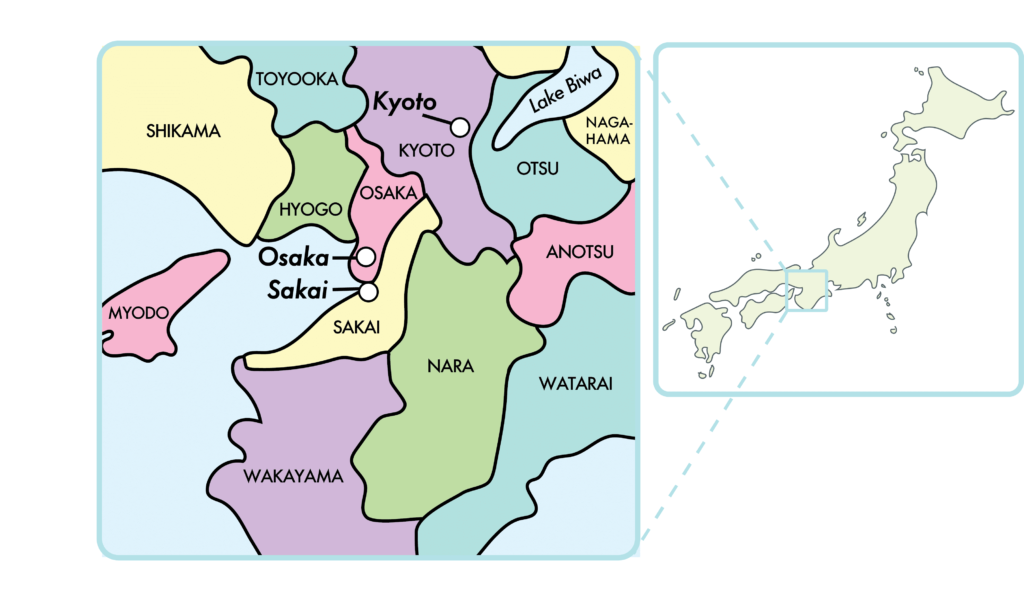
Among the early changes to Japan’s administrative structure following the Meiji Restoration was the introduction of prefectures. In 1871, these fully replaced domains, in most cases corresponding directly to previously existing domains or provinces.[54] However, Osaka Prefecture was established in 1968, before the total abolition of domains, being created from the existing city as defined by the area covered by the shogun’s assigned castellan and governors.[55] This means that the prefecture was originally considerably smaller than even today’s Osaka City. Osaka’s status as one of the first prefectures and as a city formerly governed directly by the shogun’s government can still be seen today in its name: while most prefectures have the suffix -ken (such as Hiroshima-ken or Fukushima-ken), Osaka and Kyoto are the only ones that still take the suffix -fu instead. As prefectural borders were adjusted in the early years of the system, Osaka Prefecture soon absorbed the eastern parts of the old Settsu Province, while the rest became the new Hyogo Prefecture.[56] Meanwhile, the former provinces of Kawachi and Izumi became Sakai Prefecture. For a short time, the old Yamato Province – now Nara Prefecture – was amalgamated into Sakai Prefecture, before both became part of Osaka Prefecture. Shortly afterwards, Nara Prefecture was again separated from Osaka, leaving the prefectures in the form we can see today. Many of these changes and simplifications were carried out in order to reduce the number of bureaucrats required to keep the system running. With a similar goal in mind, the finalisation of Japan’s 47 prefectures was followed by the introduction of municipalities.[57] Among the newly designated cities were Sakai and Osaka, with the latter being further divided into four wards: north, south, east and west. Since then, Osaka has expanded through the absorption of neighbouring counties on three occasions – in 1897, 1925 and 1955 – and with the addition of land reclamation in Osaka Bay, this created the borders of modern-day Osaka City.
Today, Osaka City has a mayor, while the prefecture has a prefectural governor, both chosen through public elections. When Osaka City was first founded, however, laws did not allow for it to have a dedicated city mayor: along with Tokyo and Kyoto, these cities with multiple wards were under the control of the prefectural governor, who took on the role of mayor.[58] After strong opposition to this system in all three cities, the laws were changed in 1898, creating the new position of Osaka Mayor, first held by former businessman Tamura Tahee.[59] Prior to the Second World War, the mayor was elected by the city council, but from 1947 onwards, mayors and governors have been chosen through a public election.[60] Among the notable mayors and governors to be elected in Osaka is Kuroda Ryoichi, who served as the prefectural governor from 1971 to 1979, in the process becoming the first governor to be re-elected with the sole support of the Japanese Communist Party.[61] Osaka Prefecture was also the first to have a female governor, with Ota Fusae being elected in 2000 following the previous governor’s resignation in the wake of a sexual harassment scandal.[62] In more recent years, the roles of governor and mayor have both been dominated by Hashimoto Toru and his allies, whose Osaka Metropolis Plan will be detailed further in the next section.[63] Aside from local elections, Osaka is also represented in national elections. The Japanese Diet has two elected houses – the House of Representatives and the House of Councillors – both elected through a combination of single-seat constituency voting and proportional representation.[64] The House of Councillors only came into existence after the Second World War, before which the upper chamber was the unelected House of Peers.[65] The system of voting has also seen reform at several points, with the proportional representation element only being introduced in the 1990s, as an eventual compromise after heavy criticism of the way the existing system prevented the formation of competitive party politics.[66] Voter turnout in Osaka Prefecture has been consistently below the national average in elections to the Diet.[67] However, turnout across the country has also dropped significantly in the 21st century, suggesting low political engagement that may be attributed to the lack of meaningful change after the 1990s electoral reform.[68]
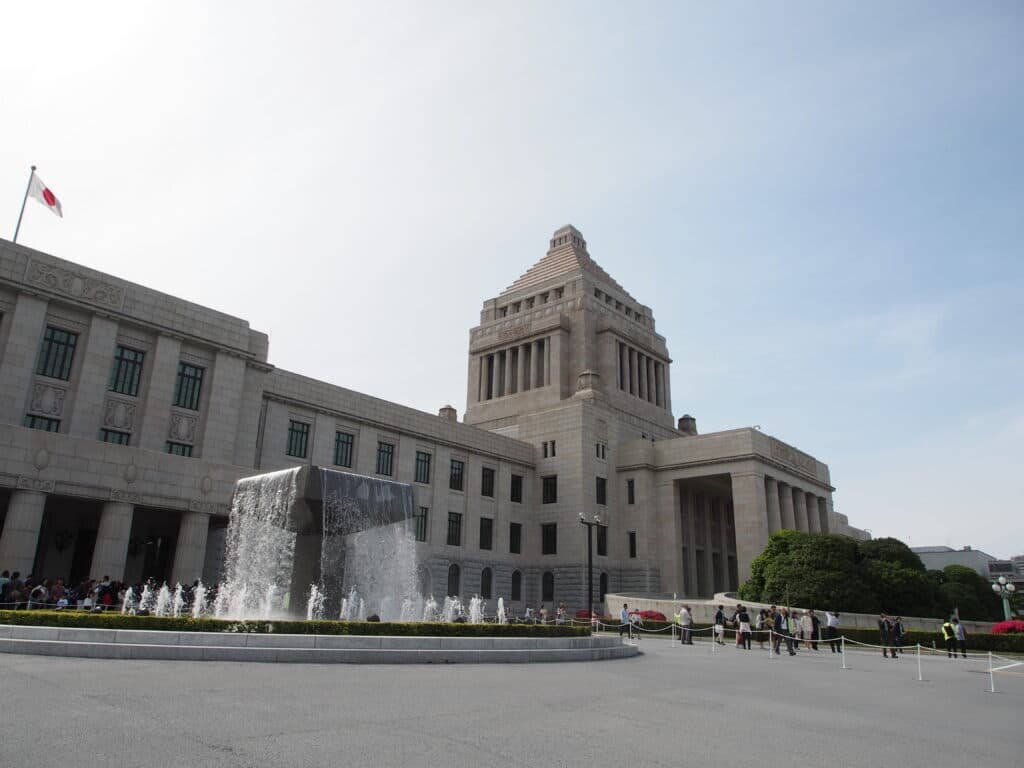
Source: Wikipedia
While today’s response to the poor performance of elected officials may largely be apathy, this was not always the case during the 20th century. In particular, the period from 1905 to 1918 is know for frequent civil unrest, beginning with the Hibiya Riot in Tokyo following the Russo-Japanese War.[69] At the end of the so-called “era of popular violence”, the Japanese military was deployed in Russia once again, seeking to further Japan’s national interests during the fallout from the Russian Revolution.[70] The argument for involvement was initially that Japan would be helping their allies prevent Germany from taking advantage of the situation in Russia at a crucial stage of the First World War, but with the war’s end only a few months after the beginning of the Siberian Intervention, the message was changed to an anti-Bolshevik slant instead. Sending troops to Siberia was not a popular idea in Japan, and this lack of public support for the effort was only exacerbated by the fact that it coincided with the 1918 Rice Riots.[71] A combination of the war effort and the Spanish Flu pandemic weakened the economy, leading to a huge rise in the cost of rice, which quickly boiled over into widespread unrest. This began in July in the rice growing prefecture of Toyama, before moving on to Nagoya and other major cities in August. The riots in Osaka, coming soon after the announcement that Japan would be involved in the Siberian Intervention, saw record-breaking numbers of participants, approaching 230,000. Coverage of the riots by the Osaka Asahi newspaper, which had already suffered from official censorship for being particularly outspoken in its opposition to military intervention in Russia, resulted in a government effort to have the paper shut down.[72] Ultimately the attempt to destroy the newspaper failed, and it is still around today: the Asahi Shimbun as it is now known is one of Japan’s oldest and largest national daily newspapers, having been founded in Osaka in 1879.[73] In the end, the Rice Riots did not prevent the Siberian Intervention from taking place, but the military excursion was seen largely as a failure, and the riots served as an opportunity for Seki Hajime, soon to be the mayor of Osaka. During his time as a government official up to that point, he had witnessed the negative impact of industrialisation and municipal expansion on the people of the city.[74] The riots and the resulting harsh clampdown inspired Seki to bring about social reform as mayor, constructing many public facilities including the completion of the municipal subway. Though Seki could not achieve all of his goals, his efforts illustrate how civil unrest of the early 20th century eventually did prompt officials to tackle the inefficacy of public institutions and implement policies for the good of the people.
In the decades after the Second World War, another theme that has emerged in opposition to government policy is peace activism. One prominent figure in this movement was Osaka-born Oda Makoto, who first became known for writing a bestselling account of his zero-budget travels around the world.[75] His experiences as a child in Osaka during the bombing campaigns on the city at the end of the Second World War informed his views on war and peace, leading him to emphasise the way in which war forces people to become both victim and victimiser.[76] After becoming established as a writer in the early 1960s, Oda was recruited to become one of the leaders of a new organisation, Beheiren, which was founded in 1965 to protest against Japanese involvement in the Vietnam War.[77] Among Beheiren’s ranks were a great number of Japan’s most prominent intellectuals, including writer and reporter Kaiko Takeshi, who, much like Oda, had first-hand experience of the attacks on Osaka.[78] During the war, Beheiren helped American deserters move on to destinations like France and Sweden, and carried out major protests, including rallies in downtown Osaka and Tokyo in 1969.[79] Another issue for many peace activists is the question of Japan’s responsibility for war crimes in the Second World War. In response to controversy surrounding the censorship of sections in textbooks on Japan’s wartime role, the Peace Boat organisation was founded, chartering a ship to visit other Asian countries and initiate cooperation.[80] Since then, the organisation has grown and continued to sail to different parts of the world promoting peace, under the leadership of Yoshioka Tatsuya, who was born in Hirakata, Osaka Prefecture.[81] Also involved in the founding of Peace Boat was Tsujimoto Kiyomi, a native of Nara Prefecture who was raised in Osaka and in more recent years has represented Osaka’s 10th District in the House of Representatives.[82] Commitment to peace is a unifying factor among these various figures, and although activism of this nature was widespread between the 1960s and 1980s, it is arguably even more important now, at a time where public apathy is high and many mainstream politicians seek to revise the Japanese Constitution.[83]

Source: Wikipedia
In many ways, the era between the Meiji Restoration and the end of the 20th century is one where Osaka played a somewhat peripheral role. A great number of the major actors in bringing about the restoration were from former domains in Kyushu, while the official moving of the capital meant that Tokyo was now the country’s political centre. The makeup of the political class reflected this, and so Osaka’s political significance was diminished. Indeed, of the many prime ministers Japan has had since the late 19th century, not one has come from Osaka, despite its status as one of Japan’s three main cities at the beginning of the modern era.[84] However, Osaka’s regional importance has remained, with the prefecture absorbing nearby cities such as Sakai, and the city itself growing enormously. In addition, Osaka played a role in events affecting the whole country, such as the Rice Riots of 1918, and contributed institutions including the Asahi Shimbun and influential people including Oda Makoto and Kaiko Takeshi. Osaka therefore affected 20th-century national politics in more indirect ways, setting the stage for more different kinds of influence in the 21st century.
New Politics for a New Millennium
Osaka is often contrasted with Tokyo, to the point where it may come across as deliberately contrarian. A contributing factor to this perception is no doubt the city’s position in the Edo Period as a commercial centre where merchants held sway while Tokyo’s predecessor of Edo was dominated by samurai, the military and bureaucratic leaders of the country. As a result, Osaka’s cultural background differs from that of the capital. In more recent times, politics in Osaka has also diverged from the national mainstream, with many headline-grabbing stories featuring Hashimoto Toru and his Osaka Metropolis Plan. This section will go into some more detail about Hashimoto, his political party Ishin no Kai, and some of the other recent trends in the politics of Osaka.
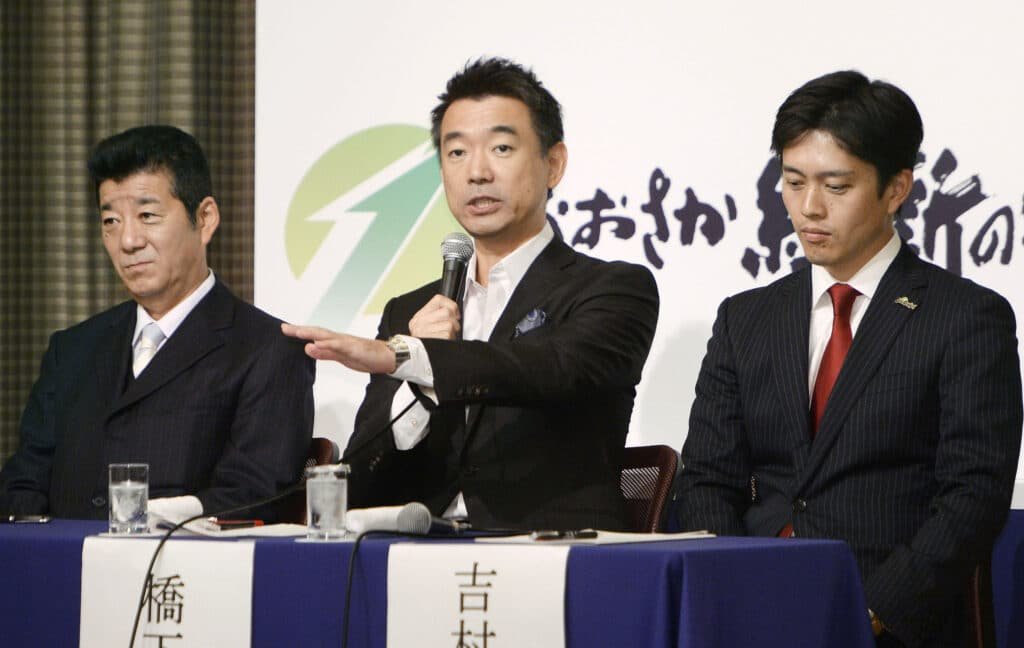
Source: The Japan Times
A former lawyer and TV personality, Hashimoto Toru’s first electoral success came in the Osaka Prefecture gubernatorial election of 2008. In this election, Hashimoto received support from the LDP (Liberal Democratic Party), Japan’s traditionally most powerful party, but his campaign stressed an independent attitude, and the LDP chose to cultivate that image by taking a background role.[85] However, after being elected as governor, Hashimoto frequently clashed with the LDP, especially over his signature proposal to dissolve Osaka City and Prefecture and merge them into a single metropolis, comparable to Tokyo. In his years as governor, Hashimoto won over several defectors from the main parties – the LDP and DPJ (Democratic Party of Japan) – allowing him to build up his own party, Osaka Ishin no Kai. He and his party soon enjoyed great success, scoring major victories over the mainstream parties and winning the elections for both Osaka Mayor – for himself – and prefectural governor – for his ally Matsui Ichiro, a former LDP member – in 2011. In the mayoral election, voter turnout increased considerably compared with the previous election, demonstrating the power of Hashimoto’s image as a political outsider.[86]
As a populist, Hashimoto was a polarising figure as mayor, with an abrasive style, tendency towards controversial statements and inconsistent policies. In some cases, he expressed an opposition to discrimination, such as when newspaper articles targeted his family history as part of the burakumin, descendants of the Edo Period outcaste groups constituting a social minority that is widely considered a taboo topic.[87] Similarly, he responded angrily during a debate with Sakurai Makoto, leader of a far-right organisation, and accused him of racism against ethnic Koreans; the two nearly even came to blows.[88] On the other hand, he failed to provide support for groups working against discrimination, cutting budgets and allowing conservative interests to cause lasting damage to the progressive message of public museums like Peace Osaka under his watch.[89] He has also expressed interest in revising Article 9 of the Japanese Constitution to remove the renunciation of war, similar to top LDP politicians like Abe Shinzo. This is apparently low on the agenda though, as a collaboration with controversial former governor of Tokyo Ishihara Shintaro – who fiercely promotes expanding the military – turned out to be brief.[90] Hashimoto’s focus was instead on his Osaka Metropolis Plan; this was put to a public referendum in 2015, and after the proposal was narrowly defeated, he officially stepped down from politics.
Although Hashimoto quit as mayor in 2015, he remains influential through his successors in Osaka Ishin no Kai.[91] These include Matsui Ichiro, who remained in his position as governor after Hashimoto stepped down as mayor, and Yoshimura Hirofumi, who was elected as mayor in 2015. Soon after Yoshimura’s election, the two expressed an ambition and began taking action to make Osaka into the country’s “vice capital”.[92] Since then, they have promoted campaigns including Osaka’s successful bid to host its second World Expo in 2025, as well as to open one of Japan’s first legal casinos.[93] More recently, they stoked controversy by simultaneously stepping down and then running for each other’s former positions in 2019 joint elections.[94] The risk paid off and they both won comfortably, helping them to overcome opposition to the ongoing Osaka Metropolis Plan. The party has also been influential at a national level. Efforts were made to contest seats around Japan as early as 2012, but after a few name changes and short-lived mergers, the national arm of the party has been known as Nippon Ishin no Kai since 2016.[95] The final name change followed a national House of Councillors election in which the party made gains, but only in Osaka and neighbouring Hyogo Prefecture.[96] In the lead-up to the 2017 House of Representatives election, they formed an alliance with former LDP cabinet minister and Tokyo governor Koike Yuriko’s Party of Hope, achieving mixed results.[97] A greater success story could be seen in the 2019 House of Councillors election, where Ishin no Kai not only managed to win seats far from the Kansai region in Tokyo and Kanagawa, but increased their representation to become the third-largest party not in government in the upper chamber.[98] In the process, they won almost forty percent of the vote in Osaka Prefecture and comfortably filled half of the prefecture’s seats.[99] Since then, the party’s position has been bolstered by Suga Yoshihide being installed as the LDP’s new prime minister, as he is close to Matsui in particular, and is therefore seen as an ally to Ishin no Kai.[100] This strong connection to central authority could be a major boost to the party’s plans in Osaka.
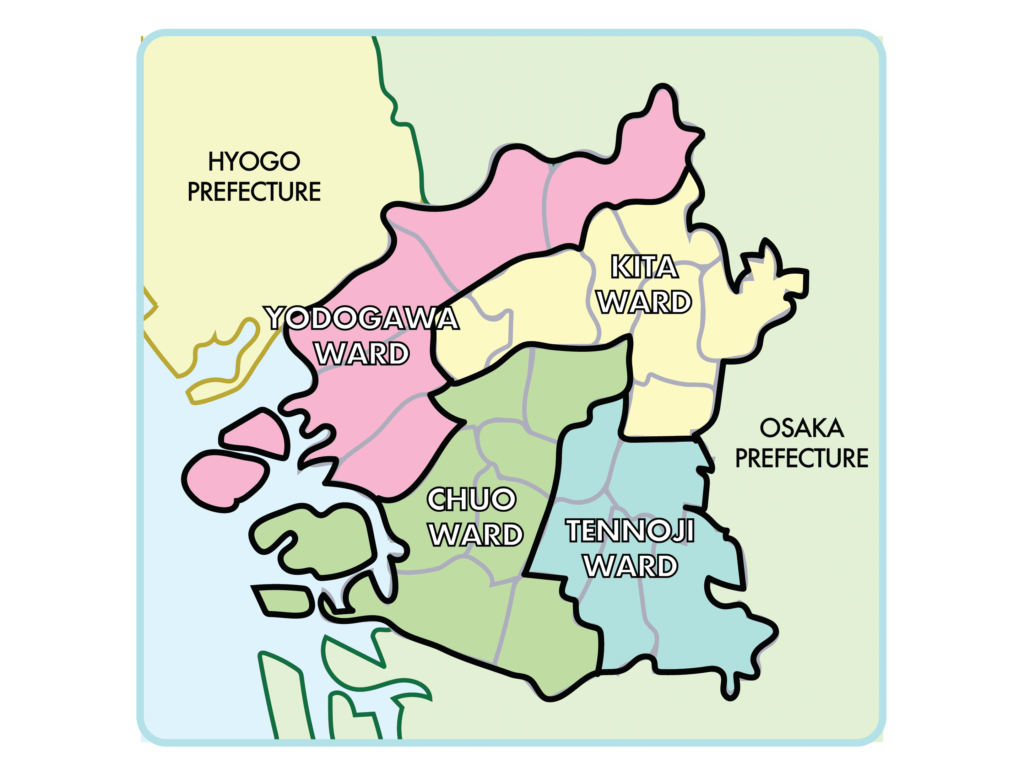
Of course, the most high-profile of Ishin no Kai’s policies is the Osaka Metropolis Plan. The basic idea is one that has appeared previously, in the 1950s and 2000s: Osaka should be restructured in order to resolve its administrative issues, particularly those stemming from the simultaneous existence of Osaka City and Prefecture.[101] Hashimoto’s version of this idea, most likely coming about due to frustration in implementing policies early in his governorship, is to turn Osaka City (Osaka-shi) into Osaka Metropolis (Osaka-to), which would be made up of a small number of “special wards”, similar to Tokyo since the 1940s. According to early proposals, Sakai and nine other cities would also have been absorbed into the new metropolis for a total of twenty special wards.[102] The plan was later scaled back, particularly after the idea proved unpopular in Sakai, which itself has a long history of independence.[103] In 2012, a law was passed by the National Diet that would enable any city with at least two million residents to re-organise themselves, subject to a referendum.[104] In a blow to Hashimoto’s original plan, though this law enabled Osaka to structure itself like Tokyo, it also specified that it did not allow newly reorganised cities to style themselves as to, or “metropolis”. Regardless, the referendum went ahead in 2015, asking citizens whether to abolish the existing Osaka City and set up five special wards, which would individually be administered at the same level as a regular city.[105] Turnout was above average, and the plan was defeated by a margin of less than one percent, which was damaging for Hashimoto and Ishin no Kai, but not enough to kill off the idea for good.[106] Following further revisions including reducing the number of wards again, the idea is set to be put to the public once more.[107] In the meantime, the cause has gained the support of Komeito – the LDP’s junior coalition partners in government – and official opposition to another referendum by the LDP has been withdrawn.[108] An Ishin no Kai candidate also narrowly won the Sakai mayoral election, suggesting that resistance may be ebbing there too.[109] Though concerns have been raised over holding another vote while Japan is still affected by the coronavirus pandemic, support for the proposal itself appears to be high, and the new referendum is planned for November 2020.[110] Criticism of the plan remains, often revolving around suggestions that it is a distraction from dealing with the roots of Osaka’s issues and likely to be too expensive to justify the supposed savings the plan would bring, but we may learn soon enough whether Ishin no Kai will achieve their ultimate goal.
Based on news reports from the past few years, it is easy to imagine that the growth of Ishin no Kai is the only recent story to be told about Osaka politics. One might also think that the party’s generally conservative ideology and record of cutting funding for museums and other bodies working against discrimination is a sign that opinions in Osaka are moving in this direction too. However, there are indications to the contrary. For example, Osaka City issued Japan’s first ordinance specifically targeting hate speech in early 2016, preceding a national Hate Speech Act.[111] In 2019, it was finally possible to enact a provision in the city’s ordinance calling for the public disclosure of the names of hate speech perpetrators.[112] Meanwhile, one Osaka politician providing an alternative to Ishin no Kai is Tsujimoto Kiyomi, formerly of the Peace Boat. She was twice a member of the House of Representatives for the Socialist Democratic Party, making a swift comeback after a funding scandal early in her career.[113] She later left the party and has since represented several left-leaning parties through a number of splits and mergers, altogether representing Osaka 10th District for several years. Now a senior figure in the opposition Constitutional Democratic Party, Tsujimoto is one of the Diet’s most prominent female politicians.[114]
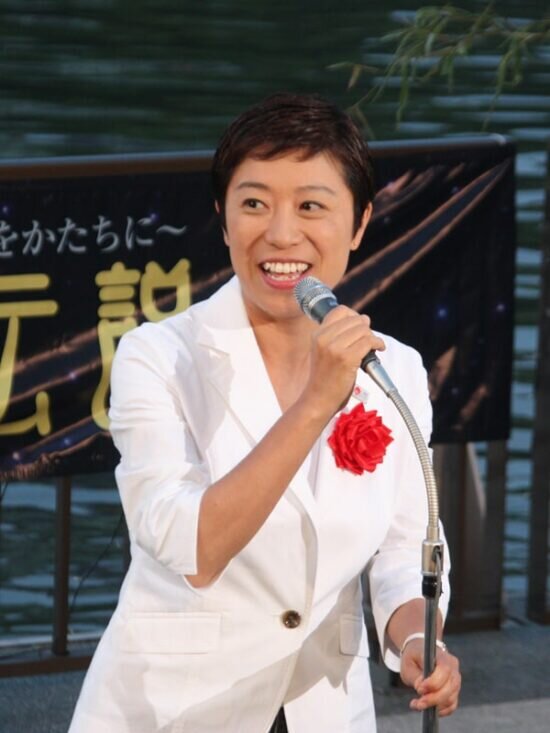
Source: Kaden Watch
Another progressive voice from Osaka is Otsuji Kanako, who in 2003 became the Osaka prefectural assembly’s youngest-ever member at the age of 28.[115] She championed the cause of allowing same-sex couples to live together in public housing, and soon publicly came out as a lesbian herself.[116] She was elected to the House of Councillors in 2013 after an earlier unsuccessful run, becoming the first openly gay member of the Japanese Diet.[117] Since then she has moved to the House of Representatives, where she remains as a member of the Constitutional Democratic Party and continues to promote the rights of minority groups. In a related development, it was reported this year that among over forty local authorities in Japan that offer same-sex marriage certificates – though these are not legally recognised everywhere – Osaka City had issued the most.[118] With this in mind, perhaps these moves to eliminate hate speech, increase women’s representation in government and improve the lives of minority groups are just as representative of today’s Osaka as the politics of Hashimoto Toru.
Summary and Conclusions
Most of the biggest news stories about Osaka in recent years relate to the topic of Hashimoto Toru’s political party Ishin no Kai and their growth. The popularity of their signature policy of the Osaka Metropolis Plan is sometimes attributed to a sense of pride among people in Osaka, and the resulting desire to be on the same level as Tokyo. Looking back over Osaka’s political history, maybe we can see some reasons that this would be the case. In the distant past, the area of today’s Osaka was home to one of the nascent Japanese nation’s first capitals, a place where great rulers made great decisions. Though the spotlight moved away in the centuries that followed, the centre of power was never far away, and the provinces making up the Osaka area were the site of dramatic events during mediaeval history. In particular, Toyotomi Hideyoshi’s founding of Osaka Castle during his campaign to come out on top following the turbulent Sengoku Period placed the area at the very centre of national politics. However, with Tokugawa Ieyasu’s new government being in Edo, Osaka developed differently, becoming the capital of commerce instead. This status as a city quite unlike the political centre of Edo – and then Tokyo – continued through the modern era. In a way, this difference is reflected in the recent emergence of locally focused politics, which provides an alternative to established national parties like the LDP but catches enough national attention to extend its influence beyond Osaka.
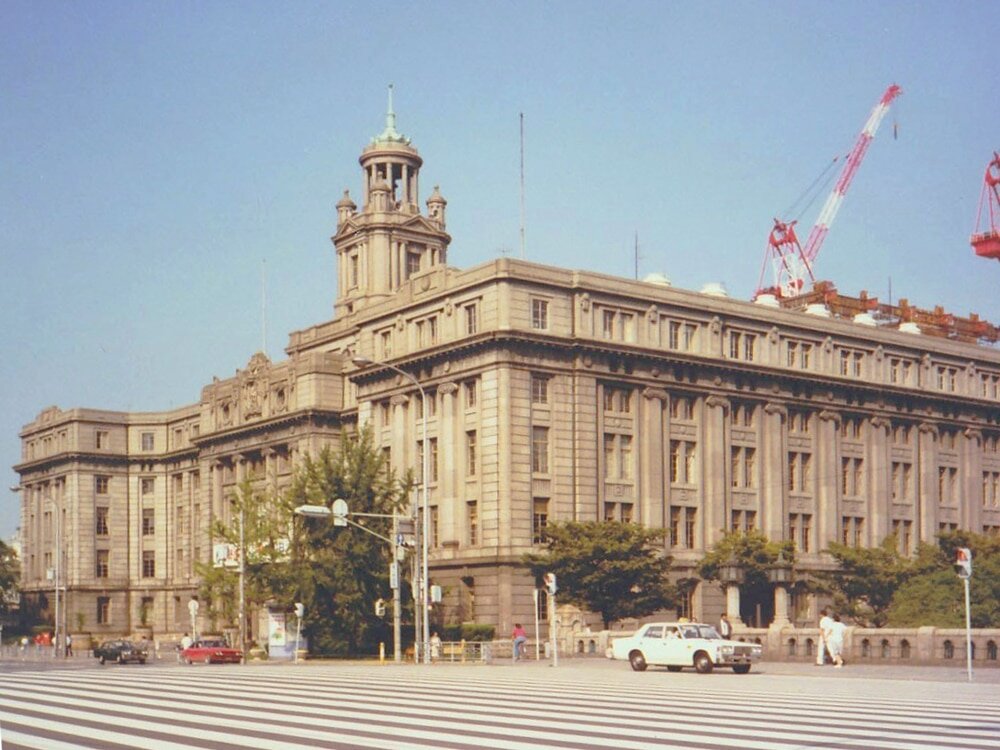
Source: Wikipedia
Considering these points, a possible concern about the Osaka Metropolis Plan is that it seeks to resolve problems in Osaka by applying the structure of Tokyo, despite the two cities being different in many ways. Indeed, there are critics of the plan who have addressed this. In the end, whether or not the plan is implemented, Osaka will remain distinct, and the issues borne of its particular history will surely be dealt with in ways that are locally appropriate. At the same time, the city is just one of many in Japan, and belongs to a global society too, so there are nationwide and worldwide problems to handle as well. Osaka’s political history is varied: Naniwa was an ancient capital, mediaeval Sakai offered an alternative model of governance, Osaka Castle was the setting for both the beginning and end of the Edo Period, and despite being somewhat on the fringes in modern Japan, recent years have seen many firsts in Osaka. More change is sure to come in the future, which may be connected with these past events, or may be something never seen before. In any case, with the politics of Osaka now featuring more prominently in the news, it is an exciting time to look out for these changes.
Except where otherwise noted, graphics are by Rachel Stewart (https://www.rachelstewartphd.com/) and other images are photographs taken by the author.
[1] ‘Osaka’. The Samurai Archives.
https://wiki.samurai-archives.com/index.php?title=Osaka
[2] 2019. ‘Beautification of the Yodogawa River Landscape’. Osaka Prefecture official website.
http://www.pref.osaka.lg.jp/attach/34342/00319640/yodogawa_English%20P1-P11.pdf
[3] Matsumura, K. ‘Kojiki and Nihon shoki (Nihongi)’. Kokugakuin University Encyclopedia of Shinto.
http://k-amc.kokugakuin.ac.jp/DM/detail.do?class_name=col_eos&data_id=23447
[4] Sakaehara, T, 2008. ‘The port of Osaka: From ancient times to today’. In: Graf, A and Huat, CB, ed. Port Cities in Asia and Europe. Routledge.
[5] ‘Nintoku, Emperor’. University of Pittsburgh.
https://www.japanpitt.pitt.edu/glossary/nintoku-emperor
[6] ‘Mozu-Furuichi Kofun Group: Mounded Tombs of Ancient Japan’. UNESCO official website.
http://whc.unesco.org/en/list/1593
[7] Frydman, J, 2019. ‘Unearthing Lost Memories: A Reexamination of the Role of Naniwa in Early Japan’. Monumenta Nipponica.
https://muse.jhu.edu/article/734129/pdf
[8] ‘The Naniwa-zu (Waka composed by Wani)’. Japanese Wiki Corpus.
[9] 2014. ‘Special Exhibition “Historical Heritage of Osaka, the Naniwa Palace Site: Exploring ancient mysteries through some keywords”’. Osaka Museum of History.
http://www.mus-his.city.osaka.jp/eng/exhibitions/special/2014/osakaisan.html
[10] Farris, W, 1998. Sacred Texts an Buried Treasures: Issues in the Historical Archaeology of Ancient Japan. University of Hawaii Press.
[11] ‘The Taika reforms’. Encyclopædia Britannica.
https://www.britannica.com/place/Japan/The-Taika-reforms#ref23133
[12] 1696-1702. ‘Settsu-no-Kuni (Genroku era)’. National Archives of Japan Digital Archive.
https://www.digital.archives.go.jp/DAS/pickup/view/detail/detailArchivesEn/0301000000/0000000227/00
[13] 1696-1702. ‘Kawachi-no-Kuni (Genroku era)’. National Archives of Japan Digital Archive.
https://www.digital.archives.go.jp/DAS/pickup/view/detail/detailArchivesEn/0301000000/0000000225/00
[14] 1696-1702. ‘Izumi-no-Kuni (Genroku era)’. National Archives of Japan Digital Archive.
https://www.digital.archives.go.jp/DAS/pickup/view/detail/detailArchivesEn/0301000000/0000000226/00
[15] 2013. ‘Origin of the city’s name and symbol’. Sakai City official website.
https://www.city.sakai.lg.jp/shisei/gaiyo/profile/yurai.html
[16] Cartwright, M, 2017. ‘Genpei War’. Ancient History Encyclopedia.
https://www.ancient.eu/Genpei_War/
[17] ‘Fukuhara-kyo (Capital of Fukuhara)’. Japanese Wiki Corpus.
https://japanese-wiki-corpus.github.io/history/Fukuhara-kyo%20(Capital%20of%20Fukuhara).html
[18] ‘Kawachi-Genji’. Japanese Wiki Corpus.
https://japanese-wiki-corpus.github.io/history/Kawachi-Genji.html
[19] ‘Golden Fantasies: Japanese Screens from New York Collections’. Asia Society.
http://sites.asiasociety.org/arts/japanesescreens/scr01.html
[20] Cartwright, M, 2019. ‘Kamakura Period’. Ancient History Encyclopedia.
https://www.ancient.eu/Kamakura_Period/
[21] Cartwright, M, 2019. ‘Shogun’. Ancient History Encyclopedia.
https://www.ancient.eu/Shogun/
[22] ‘Shugo’. The Samurai Archives.
https://wiki.samurai-archives.com/index.php?title=Shugo
[23] ‘Ashikaga Takauji’. The Samurai Archives.
https://wiki.samurai-archives.com/index.php?title=Ashikaga_Takauji
[24] ‘Hosokawa clan’. Japanese Wiki Corpus.
https://japanese-wiki-corpus.github.io/family/Hosokawa%20clan.html
[25] ‘The Onin War (1467-77)’. Encyclopædia Britannica.
https://www.britannica.com/place/Japan/The-Onin-War-1467-77
[26] ‘Sengoku Period’. The Samurai Archives.
https://wiki.samurai-archives.com/index.php?title=Sengoku_Period
[27] ‘Sengoku Daimyo 1545 (map)’. The Samurai Archives.
www.samurai-archives.com/1545.html
[28] Pearson, R, 2016. ‘Japanese medieval trading towns: Sakai and Tosaminato’. Japanese Journal of Archaeology.
http://www.jjarchaeology.jp/contents/pdf/vol003/3-2_089-116.pdf
[29] Graham, P, Yiengpruksawan, M and Miura, M, 2003. ‘Osaka’. Grove Art Online.
[30] Sugiyama, S, 1994. ‘Honganji in the Muromachi-Sengoku Period: Taking Up the Sword and its Consequences’. Journal of the Institute of Buddhist Studies.
http://www.shin-ibs.edu/documents/pwj-new/new10/02Sugiyama.pdf
[31] 2017. ‘Ishiyama Hongan-ji Temple: The Temple that Created Osaka’. Kansai Odyssey.
http://kansai-odyssey.com/the-temple-that-created-osaka-ishiyama-hongan-ji-temple/
[32] Woods, S. ‘The Three Unifiers of Sengoku Era Japan’. About Japan.
https://aboutjapan.japansociety.org/the-three-unifiers-of-sengoku-era-japan
[33] ‘Osaka Castle history’. Osaka Castle official website.
https://www.osakacastle.net/english/history/index.html
[34] ‘Osaka Campaign’. The Samurai Archives.
https://wiki.samurai-archives.com/index.php?title=Osaka_Campaign
[35] Atsushi, K, 2020. ‘Toyotomi Hideyoshi’s Japan: Taking Control of the State’. Nippon.com.
https://www.nippon.com/en/japan-topics/b06906/
[36] Szczepanski, K, 2019. ‘The Four-Tiered Class System of Feudal Japan’. ThoughtCo History & Culture.
https://www.thoughtco.com/four-tiered-class-system-feudal-japan-195582
[37] ‘Sakoku (Closure of Country)’. National Graduate Institute for Policy Studies.
https://www.grips.ac.jp/teacher/oono/hp/docu03/sakoku.pdf
[38] Hall, J. ‘Japan’s Sixteenth-Century Revolution’. In: Elison, G and Smith, B, ed. 1981. Warlords, Artists, and Commoners: Japan in the Sixteenth Century. University of Hawaii Press.
[39] Ohno, K. ‘Edo Period: Pre-conditions for Industrialization’. National Graduate Institute for Policy Studies.
https://www.grips.ac.jp/teacher/oono/hp/lecture_J/lec02.htm
[40] Hauser, W, 1977. ‘Osaka: A Commercial City in Tokugawa Japan’. Urbanism Past & Present.
https://www.jstor.org/stable/44403551
[41] Tsukada, T and Yagi, S, 2020. ‘Early Modern Osaka from the Documents: An Overview of Early Modern Osaka’s History’. Osaka City University.
https://www.lit.osaka-cu.ac.jp/MSGEM/research/early-modern-osaka-from-the-documents-2/
[42] Tsukada, T, 2012. ‘The Urban History of Osaka’. City, Culture and Society.
[43] Johnston, E, 2001. ‘The importance of being Osakan’. The Japan Times.
https://www.japantimes.co.jp/community/2001/05/20/general/the-importance-of-being-osakan/
[44] Tsukada, T and Yagi, S, 2020. ‘Early Modern Osaka from the Documents: The Cho – The Basic Unit of Urban Residential Life in Early Modern Osaka’. Osaka City University.
https://www.lit.osaka-cu.ac.jp/MSGEM/research/early-modern-osaka-from-the-documents-3/
[45] Sheldon, C, 1983. ‘Merchants and Society in Tokugawa Japan’. Modern Asian Studies.
https://www.jstor.org/stable/312302
[46] Roberts, G, 1986. ‘Oshio Heihachiro and his revolt of 1837’. Massey University.
https://mro.massey.ac.nz/handle/10179/14247
[47] ‘Bakumatsu Period’. The Samurai Archives.
https://wiki.samurai-archives.com/index.php?title=Bakumatsu
[48] 2018. ‘Bakumatsu 150th Anniversary’. Osaka Castle official website.
https://www.osakacastle.net/bakumatsu_ishin150/about_en
[49] Pampling, G, 2018. ‘An audience with the Shogun’. Far Beyond the Miyako.
[50] Kato, 2017. ‘The Battle of Toba-Fushimi’. Samurai World.
https://samurai-world.com/the-battle-of-toba-fushimi/
[51] Bacon, P. ‘Battle of Fushimi Toba’. Japan Visitor.
https://www.japanvisitor.com/japanese-culture/history/fushimi-toba
[52] Huffman, J, 2003. ‘The Meiji Restoration Era, 1868-1889’. Japan Society.
https://aboutjapan.japansociety.org/the_meiji_restoration_era_1868-1889
[53] ‘130 Years Ago: Japan’s First General Election’. Meiji Showa.
https://www.meijishowa.com/calendar/156/07-01-1890-japan-first-general-election
[54] ‘Timeline of Modern Japan (1868-1945)’. Japan Society.
https://aboutjapan.japansociety.org/content.cfm/timeline_modern
[55] ‘From the return of land to the emperor to the abolition of feudal domains (Kinki region)’. Issie geography page.
http://www.tt.rim.or.jp/~ishato/tiri/huken/h-kinki.htm
[56] ‘Changes in prefectures’. Issie geography page.
http://www.tt.rim.or.jp/~ishato/tiri/huken/k-kinki.htm
[57] Mosk, C, 2000. Japanese Industrial History: Technology, Urbanization, and Economic Growth. M.E. Sharpe.
[58] Ohsugi, S, 2011. ‘The Large City System of Japan’. National Graduate Institute for Policy Studies.
http://www3.grips.ac.jp/~coslog/activity/01/04/file/Bunyabetsu-20_en.pdf
[59] ‘Profile of Osaka city’. Osaka City official website.
https://www.city.osaka.lg.jp/contents/wdu020/enjoy/en/overview/content_CityProfile.html
[60] ‘Past mayors and vice mayors’. Osaka City official website.
https://www.city.osaka.lg.jp/seisakukikakushitsu/page/0000062445.html
[61] 2003. ‘Obituary: Ryoichi Kuroda’. The Japan Times.
https://www.japantimes.co.jp/news/2003/07/29/national/obituary-ryoichi-kuroda/
[62] Tolbert, K, 2000. ‘Election of First Female Governor Boosts Japan’s Ruling Party’. Washington Post.
https://www.washingtonpost.com/wp-srv/WPcap/2000-02/08/062r-020800-idx.html
[63] Johnston, E, 2020. ‘Osaka Gov. Hirofumi Yoshimura: From man of the hour to future prime minister?’ The Japan Times.
[64] ‘The Government of Modern Japan: Elections’. Columbia University.
http://afe.easia.columbia.edu/special/japan_1900_elections.htm
[65] Fahey, R, 2019. ‘Japan Explained: The House of Councilors’. Tokyo Review.
https://www.tokyoreview.net/2019/07/japan-explained-house-of-councilors/
[66] 2005. ‘Japan: Adapting to a New Electoral System’. The ACE Electoral Knowledge Network.
http://aceproject.org/ace-en/topics/es/annex/esy/esy_jp
[67] ‘House of Representatives general election voter turnout (districts within Osaka Prefecture)’. Osaka Prefecture official website.
http://www.pref.osaka.lg.jp/senkan/date/risyu.html
[68] ‘Changes in voter turnout in national elections’. Ministry of Internal Affairs and Communications.
https://www.soumu.go.jp/senkyo/senkyo_s/news/sonota/ritu/
[69] Gordon, A, 2011. ‘Social Protest in Imperial Japan: The Hibiya Riot of 1905’. Massachusetts Institute of Technology.
https://visualizingcultures.mit.edu/social_protest_japan/trg_essay01.html
[70] Dunscomb, P, 2018. ‘Siberian Intervention 1918-1922’. International Encyclopedia of the First World War.
https://encyclopedia.1914-1918-online.net/article/siberian_intervention_1918-1922
[71] Pasion, A, 2015. ‘Rice Riots: Japan’s “era of popular violence”’. Japan Daily.
https://japandaily.jp/rice-riots-1693/
[72] Dunscomb, P, 2006. ‘“A Great Disobedience Against the People”: Popular Press Criticism of Japan’s Siberian Intervention, 1918-22’. The Journal of Japanese Studies.
https://www.jstor.org/stable/25064608
[73] ‘141 Years Ago: Asahi Newspaper Starts’. Meiji Showa.
https://www.meijishowa.com/calendar/1699/01-25-1879-asahi-newspaper-starts
[74] Al-Badri, D, 2004. ‘The Man Who Tried to Save Osaka’. Japan Inc Communications.
https://www.japaninc.com/article.php?articleID=1300
[75] Kometani, F, 2002. ‘The Courage of His Convictions’. Time Asia (archive).
https://web.archive.org/web/20021014225023/http://www.time.com/time/asia/features/heroes/oda.html
[76] Tanaka, Y, 2007. ‘Oda Makoto, Beheiren and 14 August 1945: Humanitarian Wrath against Indiscriminate Bombing’. The Asia-Pacific Journal.
https://apjjf.org/-Yuki-Tanaka/2532/article.html
[77] Shiratori, N, 2018. ‘Peace in Vietnam! Beheiren: Transnational activism and GI movement in postwar Japan 1965-1974’. University of Hawaii.
https://scholarspace.manoa.hawaii.edu/bitstream/10125/62706/2018-08-phd-shiratori.pdf
[78] Johnston, K, 2009. ‘“What We Had Instead of Childhoods”: Experience as Remembrance in the Vietnam of Kaiko Takeshi’. University of Massachusetts Amherst.
https://scholarworks.umass.edu/cgi/viewcontent.cgi?article=1368&context=theses
[79] Andrews, W, 2014. ‘1969 Shinjuku Nishiguchi Chika Hiroba: Shinjuku Station West Exit Underground Plaza and the Anti-War “Folk Guerrillas”’. Throw Out Your Books.
[80] ‘About Peace Boat’. Peace Boat official website.
https://peaceboat.org/english/about-peace-boat
[81] Fukada, T, 2008. ‘It’s a voyage of discovery for Peace Boat couple’. The Japan Times.
[82] ‘Profile’. Tsujimoto Kiyomi official website.
[83] ‘Background’. Global Article9 Campaign.
http://www.article-9.org/en/about/index.html
[84] ‘List of prime ministers of Japan’. Encyclopædia Britannica.
https://www.britannica.com/topic/list-of-prime-ministers-of-Japan-1812632
[85] Victor, K and Hijino, L, 2013. ‘Delinking National and Local Party Systems: New Parties in Japanese Local Elections’. Journal of East Asian Studies.
https://www.jstor.org/stable/23419011
[86] Takayama, Y, 2012. ‘Interpreting the Osaka Mayoral Election through Tocqueville – Issues with Japanese Democracy’. Waseda Online.
https://yab.yomiuri.co.jp/adv/wol/dy/opinion/gover-eco_120123.html
[87] Johnston, E, 2012. ‘Hashimoto likens weekly’s slur to hate speak’. The Japan Times.
https://www.japantimes.co.jp/news/2012/11/03/national/hashimoto-likens-weeklys-slur-to-hate-speak/
[88] McCurry, J, 2014. ‘Japanese “hate speech” debate abandoned as insults fly’. The Guardian.
[89] Seaton, P, 2015. ‘The Nationalist Assault on Japan’s Local Peace Museums: The Conversion of Peace Osaka’. The Asia-Pacific Journal.
https://apjjf.org/2015/13/30/Philip-Seaton/4348.html
[90] Hongo, J, 2015. ‘Reported by WSJ: The Rise and Fall of Toru Hashimoto’. The Wall Street Journal.
https://www.wsj.com/articles/BL-JRTB-19983
[91] Harding, R, 2018. ‘Battle to remodel Osaka is legacy of Japan’s Trump’. Financial Times.
https://www.ft.com/content/1d7c89e4-5dec-11e8-ab47-8fd33f423c09
[92] Johnston, E, 2015. ‘Governor and mayor push for Osaka to become Japan’s vice capital’. The Japan Times.
[93] Johnston, E, 2018. ‘Osaka governor says casino resort could open by fiscal 2023’. The Japan Times.
[94] Watanabe, S, 2019. ‘Will election results boost Osaka metropolis plan?’ NHK Backstories.
https://www3.nhk.or.jp/nhkworld/en/news/backstories/429/
[95] Johnston, E, 2016. ‘In bid to go national, Osaka Ishin no Kai changes its name’. The Japan Times.
[96] ‘2016 House of Councillors election results’. The Asahi Shimbun.
http://www.asahi.com/senkyo/senkyo2016/
[97] Johnston, E, 2017. ‘Kibo no To and Osaka’s Nippon Ishin in cautious collaboration with wide policy overlap’. The Japan Times.
[98] ‘2019 House of Councillors election results’. The Asahi Shimbun.
https://www.asahi.com/senkyo/senkyo2019/
[99] Delgado Chacon, J, 2019. ‘2019 House of Councillors Election Osaka Prefecture – Part 1/2′. Medium.
[100] Johnston, E, 2020. ‘Let the Suga-Nippon Ishin bromance begin’. The Japan Times.
[101] Weathers, C, 2014. ‘Reformer or Destroyer? Hashimoto Toru and Populist Neoliberal Politics in Japan’. Social Science Japan Journal.
https://www.jstor.org/stable/43920420
[102] 2010. ‘Osaka Metropolis with 20 wards… Hashimoto’s new party’s proposal’. Yomiuri Online (archive).
[103] Fahey, R, 2019. ‘Crossing Over: Osaka’s Troubled Metropolitan Plan’. Tokyo Review.
https://www.tokyoreview.net/2019/03/crossing-over-osaka-metropolitan-plan/
[104] 2012. ‘New law for Japanese megacities’. Japan Local Government Centre London.
https://www.jlgc.org.uk/en/local-governance/new-law-for-japanese-megacities/
[105] 2015. ‘How are the 5 special wards demarcated?’. Nikkei.
https://www.nikkei.com/article/DGXLASHC21H3P_R20C15A4000000/
[106] Delgado Chacon, J, 2019. ‘Ishin no Kai: A third force in Japanese Politics’. Medium.
https://medium.com/@javierdelgadoch95/ishin-no-kai-3f71c67a3c55
[107] Sasagawa, S, 2020. ‘2nd referendum on Osaka metropolis plan set for November’. The Asahi Shimbun.
http://www.asahi.com/ajw/articles/13696816
[108] Matsuura, Y, 2019. ‘LDP turns around on Osaka metropolis plan, OKs referendum’. Mainichi Japan.
https://mainichi.jp/english/articles/20190615/p2a/00m/0na/010000c
[109] Takada, F, Matsuura, Y and Shibamura, Y, 2019. ‘Pro-metro Osaka plan candidate narrowly wins Sakai mayoral race’. Mainichi Japan.
https://mainichi.jp/english/articles/20190610/p2a/00m/0na/006000c
[110] Tsukui, T, 2020. ‘Nearly half of voters support Osaka metropolis plan; 72% say explanation insufficient: poll’. Mainichi Japan.
https://mainichi.jp/english/articles/20200907/p2a/00m/0na/017000c
[111] Higashikawa, K, 2018. ‘Japan’s Hate Speech Laws: Translations of the Osaka City Ordinance and the National Act to Curb Hate Speech in Japan’. University of Hawaii.
http://blog.hawaii.edu/aplpj/files/2018/01/APLPJ_19.1_Higashikawa.pdf
[112] Honda, Y and Hanafusa, A, 2019. ‘Osaka publicly discloses names of hate speech perpetrators’. The Asahi Shimbun.
http://www.asahi.com/ajw/articles/AJ201912280019.html
[113] Cucek, M, 2010. ‘Tsujimoto Kiyomi Shocks the SDP and Japan’s Political Establishment’. Shisaku.
http://shisaku.blogspot.com/2010/07/tsujimoto-hiromi-shocks-dsp-and-japans.html
[114] Johnston, E, 2020. ‘Women in Japanese politics: Why so few after so very long?’ The Japan Times.
https://www.japantimes.co.jp/news/2020/03/06/reference/women-in-japanese-politics/
[115] McCurry, J, 2007. ‘First gay candidate runs in Japan’. The Guardian.
https://www.theguardian.com/world/2007/may/25/japan.gayrights
[116] 2017. ‘Kanako Otsuji elected as a member of the House of Representatives’. Out Japan.
http://out-japan.com/kanako-otsuji-elected-as-a-member-of-the-house-of-representatives/
[117] Kuwahara, R, 2019. ‘Scapegoats Not the Solution: An Interview with Otsuji Kanako’. Nippon.com.
[118] 2020. ‘Japan cities recognize 900 LGBT couples since 2015: survey’. Kyodo News.
























